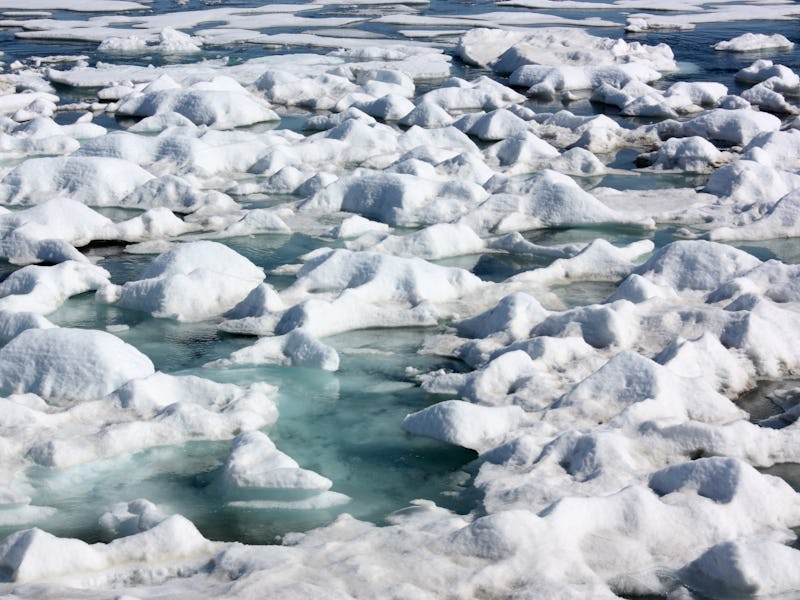5 Freaky Things Emerging From Melting Arctic Ice
Did someone say zombie anthrax?

As the Earth’s ice caps thaw and the glaciers drip-drip melt away, some really “WTF?!”-worthy stuff and bizarre consequences are about to come up. Here are five of the weirdest things that will be found underneath — and this is just the stuff we know about.
Nuclear waste
An abandoned United States Cold War military base underneath the Greenland ice sheet could one day surface, leaking nuclear and chemical waste into the planet’s oceans, a recent study published in Geophysical Research Letters has found.
The base, called Camp Century, was excavated 26 feet underneath the ice surface in 1959 to house troops and as a potential launch location for Arctic nuclear testing. The base was abandoned in 1967 under the assumption that everything left behind would stay locked up in ice forever thanks to accumulating snowfall. (Yeah, that didn’t work out.) The goods left behind veer towards toxic, including 53,000 gallons of diesel fuel, waste from a portable nuclear power reactor, sewage, and polychlorinated biphenyls, or PCBs. PCBs are a category of persistent organic pollutants that already accumulate in Arctic environments and are tied to certain cancers and other health problems.
Scientists study glacial ice melt in Greenland.
If humans fail to strongly curb greenhouse gas emissions, this particular piece of Greenland could start losing ice before the end of the century, the researchers write. After that, it would only be a matter of time before the toxic waste site becomes exposed, which could lead to an environmental disaster with dire political consequences.
“Zombie” anthrax
An anthrax outbreak this summer in Siberia has already killed more than 2,000 reindeer and made 13 people sick, according to Live Science. The likely source: carcasses of dead reindeer killed by anthrax 75 years ago and held frozen in the permafrost since then until their icy graves melted away from an unusually hot summer.
Anthrax is a hardy virus, but until now, climate change bringing the bacteria back to life in the Russian Arctic was a matter of scientific speculation. The disease ravaged Siberia between 1897 and 1925, killing millions of deer, in addition to humans and cattle. Now, all of these frozen carcasses are potential time bombs, waiting for the sun’s warmth to come bring them, in a sense, back to life.
Dead bodies
It’s not just dead deer and cows lying in wait under a frozen Arctic — an unknowable number of human bodies lay preserved in permafrost graves and under glacial ice. Anywhere that ice is retreating, there is the potential for ancient human settlements or the remains of long-lost explorers to become exposed. In northern Italy, the corpses of soldiers are slowly thawing out from beneath a glacier that covered the evidence of World War I’s “White War.”
Tourists in China visit a rapidly retreating glacier.
These melted out remains and artifacts are a boon for the study of archeology around the world, but they also impart a sense of urgency. There’s a limited window between when things become exposed again to the light of day and when they get destroyed by the elements. Researchers wishing to preserve this lost-and-found history will have to act quickly or risk losing the chance forever.
Ancient viruses
In 2014 researchers announced they had found a freakish, giant, 30,000-year-old virus in Siberian ice … that was still infectious. Fortunately, the virus in question is only capable of taking amoebae as hosts, but it raises the troubling question of what else might be lurking in the soon-to-be-unfrozen world.
But researchers aren’t too worried about the prospect of a latent killer infection: Some argue that the chances of some terrible killer virus emerging from the permafrost are slim, and that the known viral threats associated with climate change, like increased ranges for disease-carrying mosquitos, are much more troublesome.
Methane gas
Of all the things that might be uncovered by melting permafrost, the most frightening is invisible. Permafrost traps enormous quantities of methane gas, which will be released into the atmosphere as the Arctic melts. Methane is 25 times more potent as a greenhouse gas than carbon dioxide over a 100-year timeline. Current climate models do not fully account for the additional global warming that will be caused through this feedback loop.
What this means, in essence, is that as catastrophic as scientists’ predictions of climate change impacts are, these apocalyptic scenarios are very likely just the tip of the iceberg.